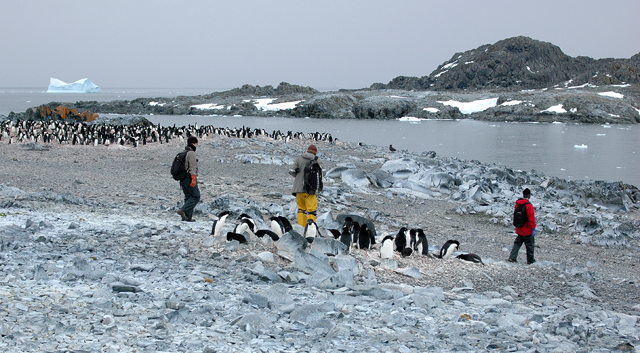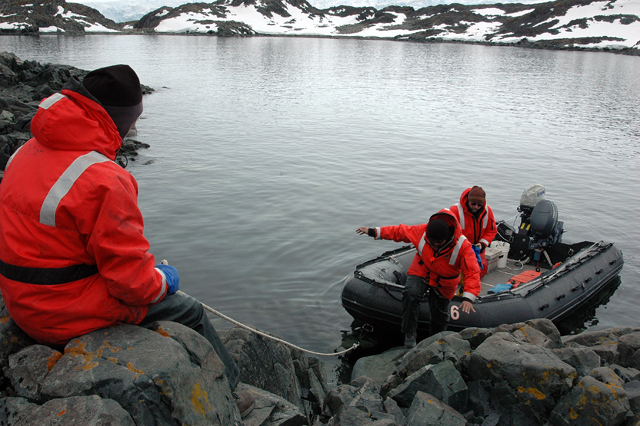Page 3/3 - Posted January 29, 2010
Climate change concerns?Teets is also conducting experiments that look at the effects of cyclic cold on the insects — whether repeated freezing and thawing affect survival or stress response. “It goes along with the whole global warming theme,” he says, explaining that while the general trend of climate change will be increased temperatures over the long term, it will be accompanied by wild shifts in shorter-term climate. Lee doesn’t think hardy Belgica has too much to worry about from climate change. Temperature loggers placed near Belgica microhabitats during their previous fieldwork recorded a wide range of temperatures over the summer and winter. The larvae can also move up and down in the substrate as surface conditions dictate to protect themselves. Comparative studiesThat could explain the absence of the larvae right now on Torgy. The island seems especially dry, the tufts of Prasiola brittle and crisp. When wet, the algal mats ribbon out, Lee notes. The hunch about Humble at first turns up disappointing results. Master’s student Yuta Kawarasaki is enjoying the most luck, gathering up the eight-legged mite, Alaskozetes antarcticus, which lives in large colonies on relatively dry stones. He wants the mites and springtails for various comparative studies to Belgica. More specifically, he wants to test whether the little animals’ levels of ATP, adenosine triphosphate, go up as temperature drops. ATP is the chemical energy of the cell that powers its metabolic activities. ATP levels usually fall with temperature in temperate species that live in warmer climes. But there’s evidence that cold-loving critters actually increase their ATP levels when the mercury drops. “We don’t know what that exactly means yet but we want to test if that holds true in Antarctic species,” says Kawarasaki, who works with Lee at Miami University. Fondness for fieldworkThis is Kawarasaki's first trip to the Antarctic. “It’s fabulous. It’s supposed to be work, but it’s fun, so I don’t know if I should call it work,” he says with his nose almost literally on the frozen ground, scraping mites off a rock and into a small vial. Juanita Constible seems equally happy to be rolling in the cold Antarctic mud, pulling up rocks and squinting for Belgica larvae in the impressions. A former lab manager and science education writer for the Ecophysiological Cryobiology Lab at Miami University, Constible is a trained wildlife biologist who now works for the National Wildlife Federation In addition to offering another pair of field hands, Constible maintains the team’s blog for the expedition, explaining the science and uploading photos that show life at a research station, reachable after a four-day cruise across open ocean from southern Chile. “I just feel incredibly lucky to be here,” she says. It’s hard not to share that feeling. White noise here is the braying of Adélie penguins and the burping and gurgling of elephant seals piled on top of one another like gigantic slugs, sounding like an underground sewer pipe about to burst. Still, the work isn’t too sexy. “It’s not just about coming to Antarctica,” Constible notes. “I’m crawling around in muck and seal poo.” But it turns out to be a good place to crawl around and get slimy. A small snow pack at the top of a short down slope provides just enough snowmelt to moisten the soil below. The larvae are everywhere. Soon the rest of the team is prone, quickly filling up their plastic bags. Several thousand specimens will be sent stateside for additional lab work, where they can survive for more than a year in a refrigerator with a little Prasiola from home and the occasional spray of water. A momentary scuffle between adult penguins creates enough of a ruckus for everyone to look and turn, and then they’re back at the business of collecting tiny creatures that could reveal some big discoveries about cold adaptation. “It’s the little things that run the world — bacteria microbes, phytoplankton — all this other stuff, the bigger animals, are just superfluous,” Lee says. NSF-funded research in this story: Richard Lee, Miami University, Award No. 0837559 |



For USAP Participants |
For The Public |
For Researchers and EducatorsContact UsU.S. National Science FoundationOffice of Polar Programs Geosciences Directorate 2415 Eisenhower Avenue, Suite W7100 Alexandria, VA 22314 Sign up for the NSF Office of Polar Programs newsletter and events. Feedback Form |





